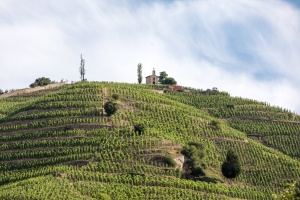Sweet Secrets of the Northern Rhône (the Misfits Series)
March 2, 2024 Leave a comment
The 30-mile (72-km)-long stretch from Vienne to Valence in France’s Northern Rhône Valley is famous for its sturdy, Syrah-dominant red wines. Just whispering the word Hermitage (or Cornas or Côte-Rôtie) is enough to make a red wine lover smile. Equally well-known—albeit produced in much smaller amounts—are the fruity, floral, and powerful white wines of Condrieu and Château-Grillet (made from 100% Viognier). The area also produces sparkling wines down along its southern edge in the Saint-Péray AOC. While the Marsanne and Roussanne-based bubblies of Saint-Péray may seem somewhat out-of-place in the rough-and-tumble Northern Rhône, they are nevertheless well-known and acknowledged among well-informed enthusiasts and students of wine.
However, there is a secret whispered among the steep, hillside vines of the Northern Rhône, and you can hear it if you really try. It sounds like this—sweet wines are made here too. You may need to tread deep into the cellars to find these wines, but they are here: Hermitage Vin de Paille and Condrieu Doux.
The Condrieu AOC—located towards the northern end of the Northern Rhône, just south of the Côte-Rôtie—is a white wine-only appellation producing richly flavored and -textured wines from 100% Viognier. Like most Viognier-based wines, Condrieu AOC tends to be wildly aromatic, showing perfume-like scents of fruit (apricot, peach, tangerine, mango, fruit cocktail); flowers (honeysuckle, rose petals, jasmine) and baking spice (cinnamon, nutmeg, anise).

Photo via: https://madrose.com/
It’s a little-known fact, but (like many French wines), Condrieu was historically produced as a sweet wine. Harvest would traditionally begin on All Saint’s Day (November 1). It was not until the mid-1950s that the leading style of Condrieu shifted to the heady, dry wines that make up the majority of the production today.
In keeping with tradition, some wineries in Condrieu still produce sweet wines (alongside their dry versions). Cave Yves Cuilleron produces a sweet (11% RS) Condrieu, Condrieu Ayguets Doux. According to their website, the south-facing aspect of the vineyard promotes over-ripeness, and the grapes (harvested in stages from mid-October to mid-November) were at least partially affected by botrytis in the 2018 vintage. The resulting sweet wine was matured for eight months in oak barriques and emerged with “notes of candied fruits, honey, wax and mild spice.”
Other examples of sweet Condrieu include Domaine du Monteillet’s Condrieu doux Candice (made from 50% botrytized grapes), Domaine Christophe Pichon Cuvée Patience, and E. Guigal Condrieu Luminescence (produced only a few times over the history of the estate using ultra-over-ripe grapes).
The Hermitage AOC—located on a famous south-facing, terraced hillside towering above the curving Rhône River and the town of Tain-Hermitage—is well-known for its sturdy, fruity-but-earthy Syrah-dominant red wines. The red wines of the region allow for the use of up to 15% (combined) Marsanne and Roussanne grapes, and white wines—based mainly on the Marsanne grape variety and known for being dry, sturdy, and long-lived—are produced as well.
Viticulture in Hermitage can be traced back thousands of years, and many people believe this hillside to be the actual—or perhaps just spiritual—birthplace of the Syrah variety. Vines were tended, and wine was produced in the area as far back as Roman times, when the local wine was referred to as the “wines of Vienne.” Among these ancient wines were sweet wines made from grapes allow to dry (raisinate) on straw mats after harvest. This style of wine—now known in this area as Vin de Paille—is being produced again, now under the auspices of the Hermitage AOC.

Photo via: https://www.chapoutier.com
According to the rules and regulations, Hermitage Vin de Paille may be produced using the Marsanne and/or Roussanne grape variety. The grapes—which may be picked at a “typical” level of sugar ripeness—are left to dry on straw mats for a minimum of 45 days and until they have a minimum must weight of 350 g/l. While not required, the rich, sweet juice is typically barrel fermented and oak aged for several years before bottling. The resulting wines are intended to be very aromatic—redolent of candied fruit—with good levels of sugar and alcohol, and very well poised for long aging.
M. Chapoutier has—since 1990—occasionally produced a Hermitage Vin de Paille; the 2009 vintage was made from 100% Marsanne grapes that had been dried on straw mats for two months before pressing. The wine produced in 2009—which the winery advises may continue to successfully age for up to 50 years—has almost 15% abv and 10.5% residual sugar. The wine (as reported by the estate) has a deep, golden yellow color and intense aromas of candied fruits and honey. It is suggested to be served with fruit desserts…or as a dessert by itself.
Sweet wines of the Northern Rhône…they are fascinating, ancient, and true misfits, but secret no more!
References/for more information:
- Cahier des Charges – Condrieu
- Cahier des Charges – Hermitage
- http://www.vin-condrieu.fr/vin-aoc/en/accueil
- https://www.cuilleron.com/en/wines/condrieu-les-ayguets
- http://www.vin-condrieu.fr/vin-aoc/fr/histoire
- https://www.vins-rhone.com/en/vineyard/appellations/hermitage
The Bubbly Professor is “Miss Jane” Nickles of San Marcos, Texas… missjane@prodigy.net

